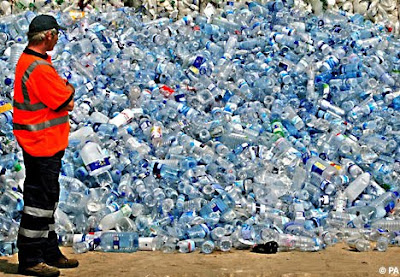Plastic bottles make water, a healthy choice in comparison to juice or soda, more convenient and accessible. Many people trust bottled water to be cleaner than that which comes out of their tap. More water companies are coming out with new packaging, catering to the growing number of people who view their bottled water as a symbol of status and style. Today, there are more than 600 brands of bottled water on the market. New brands emerge everyday, some with added benefits such as vitamins, energy, weight loss, skin supplements, etc.
So it’s no surprise that plastic water bottles are everywhere. Water is the fastest growing bottled beverage in America. A 22 billion dollar a year industry, it’s second only to soda in beverage sales. A study by Forbes showed that 1973 the average American bought only 1.6 gallons of bottled water a year. Now, the number is 28.3 gallons per year and rising.

Unfortunately the rapid rise of plastic water bottle sales contributes to the growing plastic pollution problem. Water bottles can, and should be recycled. Some states have even charged a deposit for bottles at the point of purchase to encourage recycling. But the reality is the vast majority of consumers either throw used bottles into the trash or worse, litter them. According to the Clean Air Council, America throws away 2.5 million plastic bottles per hour, or 60 million bottles a day. The Surfrider foundation maintains a running tally of plastic bottles thrown away into landfills on their site
Last time I checked, the number was
35, 491,584,972 water bottles. Statistically less than 10 percent of water bottles are recycled. It is unacceptable that plastic bottles are taking up space in landfills when they can be recycled instead. Our landfills are getting so full they are closing at the rate of 1 per day. Unrecycled plastic water bottles that don’t end up in landfills are littered and many find their way into our oceans.

















